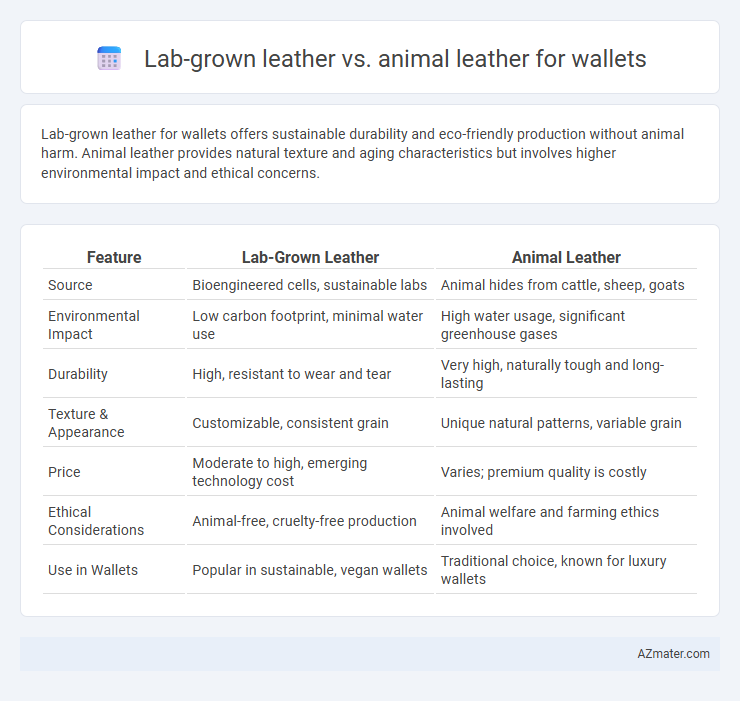Lab-grown leather for wallets offers sustainable durability and eco-friendly production without animal harm. Animal leather provides natural texture and aging characteristics but involves higher environmental impact and ethical concerns.
Table of Comparison
| Feature | Lab-Grown Leather | Animal Leather |
|---|---|---|
| Source | Bioengineered cells, sustainable labs | Animal hides from cattle, sheep, goats |
| Environmental Impact | Low carbon footprint, minimal water use | High water usage, significant greenhouse gases |
| Durability | High, resistant to wear and tear | Very high, naturally tough and long-lasting |
| Texture & Appearance | Customizable, consistent grain | Unique natural patterns, variable grain |
| Price | Moderate to high, emerging technology cost | Varies; premium quality is costly |
| Ethical Considerations | Animal-free, cruelty-free production | Animal welfare and farming ethics involved |
| Use in Wallets | Popular in sustainable, vegan wallets | Traditional choice, known for luxury wallets |
Introduction to Wallet Material Choices
Wallet material choices significantly impact durability, aesthetics, and sustainability, with animal leather long regarded for its classic look and strength. Lab-grown leather offers an innovative alternative, crafted through biofabrication processes that reduce environmental impact while mimicking the texture and resilience of traditional leather. Consumers increasingly consider ethical sourcing and ecological footprint when selecting between lab-grown and animal leather for wallets.
Overview of Lab-Grown Leather
Lab-grown leather, produced through cultured collagen or plant-based matrices, offers a sustainable and cruelty-free alternative to traditional animal leather, significantly reducing environmental impact and carbon emissions. This innovative material mimics the texture and durability of animal leather while eliminating the need for livestock farming and tanning processes that release toxic chemicals. Increasingly used in wallet manufacturing, lab-grown leather provides high-quality, eco-friendly options that appeal to conscious consumers seeking ethical fashion choices.
Animal Leather: Traditional Staple
Animal leather remains the traditional staple for wallets due to its durability, natural texture, and aging characteristics that develop a unique patina over time. High-quality animal leather wallets offer superior strength, water resistance, and a premium feel that is difficult to replicate with lab-grown alternatives. Despite environmental concerns, animal leather's established manufacturing processes and trusted performance continue to dominate the luxury wallet market.
Durability: Lab-Grown vs. Animal Leather Wallets
Lab-grown leather wallets exhibit impressive durability due to their engineered structure, often resisting scratches and moisture better than traditional animal leather. Animal leather offers natural resilience and ages uniquely over time, developing a patina that enhances its aesthetic and strength. While animal leather can be more prone to wear from environmental factors, high-quality lab-grown leather consistently maintains its integrity under similar conditions.
Eco-Impact: Sustainability Comparison
Lab-grown leather production generates significantly lower carbon emissions and water usage compared to traditional animal leather, reducing environmental degradation and resource exploitation. Its closed-loop manufacturing process minimizes chemical waste and deforestation associated with livestock farming. This sustainable approach supports biodiversity preservation and aligns with global efforts to combat climate change.
Aesthetic and Texture Differences
Lab-grown leather offers a uniform texture with customizable grain patterns, allowing for sleek, modern wallet designs that maintain a consistent aesthetic appeal. Animal leather wallets boast natural variations in texture and grain, providing unique character and a classic, tactile richness that evolves with use. Both materials differ significantly in feel: lab-grown leather tends to be smoother and more controlled, while animal leather offers a warmer, more organic touch with inherent imperfections.
Cost: Price Analysis for Consumers
Lab-grown leather offers a competitive advantage regarding cost, often priced 20-30% lower than premium animal leather wallets due to reduced material and production expenses. Animal leather wallets command higher prices because of traditional tanning processes, supply chain variability, and ethical sourcing concerns that influence consumer willingness to pay a premium. Consumers analyzing wallet costs find lab-grown leather presents a budget-friendly alternative without sacrificing texture or durability, appealing to eco-conscious buyers seeking economic value.
Ethical Considerations
Lab-grown leather offers a sustainable and cruelty-free alternative to traditional animal leather, significantly reducing animal suffering and environmental degradation. It eliminates the need for animal farming practices associated with high greenhouse gas emissions, deforestation, and water consumption. Choosing lab-grown leather wallets supports ethical consumerism by promoting innovation in eco-friendly materials while preserving animal welfare.
Consumer Preferences and Market Trends
Lab-grown leather offers a sustainable and cruelty-free alternative to traditional animal leather, appealing to eco-conscious consumers increasingly prioritizing ethical fashion choices. Market trends highlight a rising demand for lab-grown leather wallets, driven by advancements in texture quality and durability that rival animal leather. Consumer preferences are shifting towards innovative materials that combine luxury with environmental responsibility, leading to expanded product lines and growth in the lab-grown leather segment.
The Future of Wallet Craftsmanship
Lab-grown leather offers a sustainable alternative to traditional animal leather in wallet craftsmanship, reducing environmental impact and ethical concerns linked to livestock farming. Advanced biofabrication technologies enable the production of durable, high-quality materials that mimic the texture and longevity of animal leather while supporting circular economy principles. As consumer demand shifts towards eco-friendly goods, lab-grown leather wallets are poised to revolutionize artisanal design and mass production, merging innovation with heritage craftsmanship.

Infographic: Lab-grown leather vs Animal leather for Wallet
 azmater.com
azmater.com